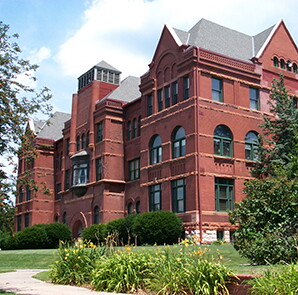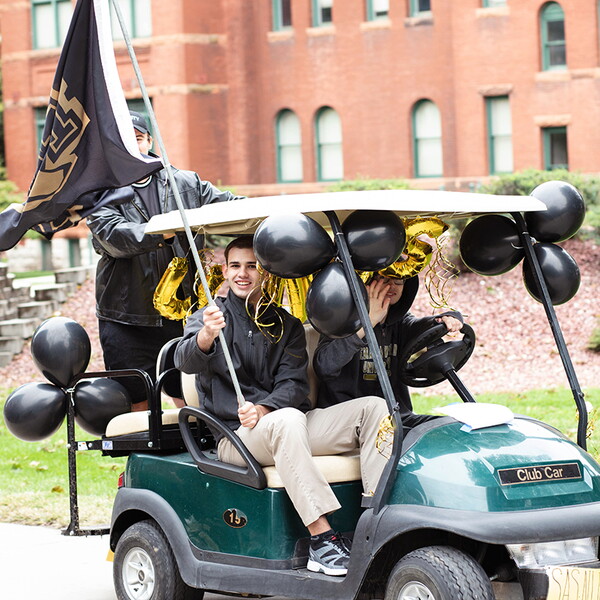Athletic Concussion Management Protocols
|
Policy title
Athletic Concussion Management Protocols
|
Category
Athletics
|
|
Owner
Athletic Training
|
Approved by
Athletic Training
|
This is the set of procedures NWU follows for all Athletic Concussion Management.
1. NWU ATHLETICS will require student-athletes to sign a statement in which student-athletes accept the responsibility for reporting their injuries and illnesses to the sports medicine staff, including signs and symptoms of concussions. During the review and signing process student-athletes will watch a NCAA video on concussions and/or be provided with educational material1 on concussions.
2. NWU ATHLETICS will have on file and annually update an emergency action plan2,3,4 for each athletics venue to respond to student-athlete catastrophic injuries and illnesses, including but not limited to concussions, heat illness, spine injury, cardiac arrest, respiratory distress (e.g. asthma), and sickle cell trait collapses. All athletics healthcare providers shall review and practice the plan annually. These sessions will be conducted prior to the start of the sport season. The NWU Athletic Training Room will maintain a list of staff that have completed the requirement on file.
3. NWU Athletic Training staff members shall be empowered to determine management and return-to-play of any ill or injured student-athlete, as he or she deems appropriate. Conflicts or concerns will be forwarded to Jason Ensrud (Director of Sports Medicine) and Doug Koch, MD (Medical Director) for remediation.
4. NWU ATHLETICS shall have on file a written team physician–directed concussion management plan2,6 that specifically outlines the roles of athletics healthcare staff (e.g., physician, certified athletic trainer, nurse practitioner, physician assistant, neuropsychologist). In addition, the following components have been specifically identified for the collegiate environment:
a. NWU ATHLETICS coaches will receive a copy of the concussion management plan, a fact sheet on concussions in sport, and view a video on concussions annually. The NWU ATHLETICS Athletic Director will maintain a list of staff that have completed the requirement on file.
b. NWU Athletic Training staff members and other athletics healthcare providers will practice within the standards as established for their professional practice (e.g., team physician7, certified athletic trainer8, physical therapist, nurse practitioner, physician assistant, neurologist9, neuropsychologist10).
c. Baseline assessment tools should be used post-injury at appropriate time intervals. The baseline assessment should consist of the use of: 1) symptoms checklist and 2) ImPACT neuropsychological testing. Neuropsychological testing has proven to be an effective tool in assessing neurocognitive changes following concussion and can serve as an important component of an institution’s concussion management plan. However, neuropsychological tests should not be used as a standalone measure to diagnose the presence or absence of a concussion as NWU ATHLETICS uses a comprehensive assessment by its Athletic Training staff.
d. When a student-athlete shows any signs, symptoms or behaviors consistent with a concussion, the athlete will be removed from practice or competition, by either a member of the coaching staff or sports medicine staff. If removed by a coaching staff member, the coach will refer the student-athlete for evaluation by a member of the Athletic Training staff. During competitions, on the field of play injuries will be under the purview of the official and playing rules of the sport. NWU ATHLETICS staff will follow such rules and attend to medical situations as they arise. Visiting sport team members evaluated by NWU Athletic Training staff will be managed in the same manner as NWU ATHLETICS student athletes.
e. A student-athlete diagnosed with a concussion will be withheld from the competition or practice and not return to activity for the remainder of that day. Student-athletes that sustain a concussion outside of their sport will be managed in the same manner as those sustained during sport activity.
f. The student-athlete will receive serial monitoring for deterioration. Athletes will be provided with written home instructions upon discharge; preferably with a roommate, guardian, or someone that can follow the instructions.
g. The student-athlete will be monitored for recurrence of symptoms both from physical exertion and also mental exertion, such as reading, phone texting, computer games, watching film, athletic meetings, working on a computer, classroom work, or taking a test. Academic advisors and professors will be notified of student-athlete’s concussion, with permission for release of information from the student athlete.
h. The student-athlete will be evaluated by a team physician or physician’s designee as outlined within the concussion management plan. Once asymptomatic, satisfactory completion of post-injury ImPACT testing, and post-exertion assessments are within normal baseline limits, return to play shall follow a medically supervised stepwise process.
i. Final authority for Return-to-Play13 shall reside with the team physician or the physician’s designee as noted in the concussion management flowchart.
5. NWU ATHLETICS will document the incident, evaluation, continued management, and clearance of the student athlete with a concussion. Aggregate concussion numbers per sport will be reported to the Director of Athletics annually.
6. Athletics staff, student-athletes and officials will continue to emphasize that purposeful or flagrant head or neck contact in any sport should not be permitted.
Reference Documents
1. NCAA and CDC Educational Material on Concussion in Sport. Available online at www.ncaa.org/health-safety
2. NCAA Sports Medicine Handbook. 2009-2010.
3. National Athletic Trainers’ Association Position Statement: Emergency Planning in Athletics. Journal of Athletic Training, 2002; 37(1):99–104.
4. Sideline Preparedness for the Team Physician: A Consensus Statement. 2000. Publication by six sports medicine organizations: AAFP, AAOS, ACSM, AMSSM, AOSSM, and AOASM.
5. Recommendations and Guidelines for Appropriate Medical Coverage of Intercollegiate Athletics. National Athletic Trainer’s Association. 2000. Revised 2003, 2007, 2010.
6. Consensus Statement on Concussion in Sport 3rd International Conference on Concussion in Sport Held in Zurich, 2008. Clinical Journal of Sport Medicine, 2009; 19(3):185-200.
7. Concussion (Mild Traumatic Brain Injury) and the Team Physician: A Consensus Statement. 2006. Publication by six sports medicine organizations: AAFP, AAOS, ACSM, AMSSM, AOSSM, and AOASM.
8. National Athletic Trainers’ Association Position Statement: Management of Sport-Related Concussion. Journal of Athletic Training, 2004; 39:280-297.
9. Practice parameter: the management of concussion in sports (summary statement). Report of the Quality Standards Subcommittee. Neurology, 1997; 48:581-5.
10. Neuropsychological evaluation in the diagnosis and management of sports-related concussion. National Academy of Neuropsychology position paper. Moser, Iverson, Echemendia, Lovell, Schatz Webbe, Ruff , Barth. Archives of Clinical Neuropsychology, 2007; 22:909–916.
11. Who should conduct and interpret the neuropsychological assessment in sports-related concussion? Echemendia RJ, Herring S, Bailes J. British Journal of Sports Medicine, 2009; 43:i32-i35.
12. Test-retest reliability of computerized concussion assessment programs. Broglio SP, Ferrara MS, Macciocchi SN, Baumgartner TA, Elliott R Journal of Athletic Training, 2007; 42(4):509-514.
13. The Team Physician and Return-To-Play Issues: A Consensus Statement. 2002. Publication by six sports medicine organizations: AAFP, AAOS, ACSM, AMSSM, AOSSM, and AOASM.
Nebraska Wesleyan University Concussion Management Plan Concussion Identified and Assessed:
Physical examination and assessment of concussion symptoms by medical staff (athletic trainer, physician assistant and/or physician: if physician not immediately available, athlete should be referred to physician for evaluation within 24 hours of injury if possible if not emergent; if emergent, athlete should be transported to closest emergency department); athlete held from all physical activity; given concussion information home instruction sheet; notify parent/guardian of concussion; Athlete repeats Symptoms checklist (within 24 hours of injury if possible)
Concussion Management:
Athlete held from all physical activity; re-assess athlete daily by medical staff; administer symptom checklist daily until completely asymptomatic; notify academic advisor (consideration of academic modifications/restrictions)
Athlete Asymptomatic (24 hours):
Pass ImPACT neuropsychological post-test, perform exertional testing; re-evaluation by physician or designee of physician for return to play decision.
Test Results NOT Returned to Normal:
When medically cleared by physician, repeat exertional testing, re-evaluation by physician for return to play decision Consider neuropsych consult with more detailed test battery.
Post-Concussion Exertional Testing Protocol
Only done after proper time elapsed based on grade of concussion or after 24 hours of being symptom free and satisfactory completion of ImPACT post-injury testing.
Exertional Testing Protocol
1. 10 min on stationary bike; exercise intensity <70% maximum predicted heart rate
2. 10 min continuous jogging on treadmill; exercise intensity <70% maximum predicted heart rate
3. Strength training: (i.e. push-ups, sit-ups, squats thrusts)
4. Advanced cardiovascular training: sprint activities
5. Advanced strength training: weight lifting exercises
6. Sport specific agility drills (no risk of contact) If no change or increase in symptoms, move to next step. Non-contact practice following completion of exertional protocol
If no change or increase in symptoms within 24 hours, move to next step.
Limited to full contact practice
If no change or increase in symptoms, final return to play decision made by medical staff.



